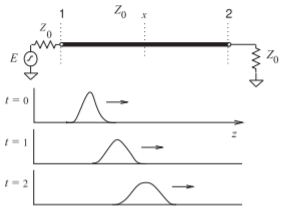4.1: Introduction
- Page ID
- 41036
Previous chapters discussed the low-frequency operation of transmission lines. This chapter describes the origins of, particularly of planar lines. Figure \(\PageIndex{1}\) shows the typical frequency dependence of a line’s \(RLGC\) parameters. The variations of \(R\), \(L\), and \(C\) are of most interest, and, except with some semiconductor substrates, \(G\) is usually negligible.
The major limitation on the dimensions and maximum operating frequency of a transmission line is determined by the origination of higher-order modes (i.e., orientations of the fields). Different modes on a transmission line travel at different velocities. Thus the problem is that if a signal on a line is split between two modes, then the information sent from one end of the line will reach the other end in two packets arriving at different times. The two modes have random partitioning of the signal

Figure \(\PageIndex{1}\): Frequency dependence of transmission line parameters.

Figure \(\PageIndex{2}\): Dispersion of a pulse along a line.
energy and it is the combination that will be detected, and in general the information will be lost as the two modes combine in an incoherent manner. Multimoding must always be avoided.


